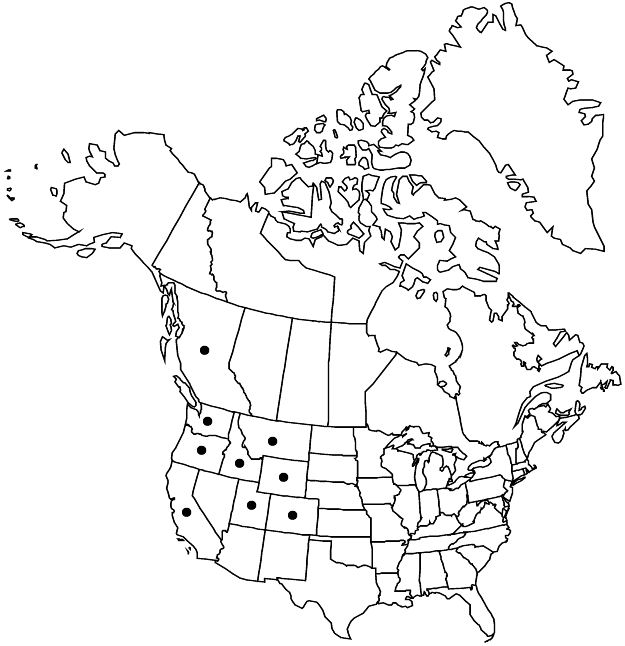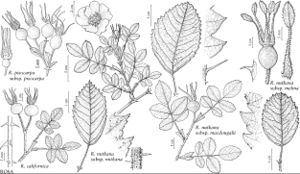Difference between revisions of "Rosa nutkana subsp. macdougalii"
Contr. U.S. Natl. Herb. 11: 335. 1906.
FNA>Volume Importer |
FNA>Volume Importer |
||
| Line 15: | Line 15: | ||
|label=Selected by author to be illustrated | |label=Selected by author to be illustrated | ||
}} | }} | ||
| − | |basionyms={{Treatment/ID/ | + | |basionyms={{Treatment/ID/Basionym |
|name=Rosa macdougalii | |name=Rosa macdougalii | ||
|authority=Holzinger | |authority=Holzinger | ||
| + | |publication_title=Bot. Gaz. | ||
| + | |publication_place=21: 36. 1896 (as macdougali) | ||
}} | }} | ||
|synonyms={{Treatment/ID/Synonym | |synonyms={{Treatment/ID/Synonym | ||
| Line 43: | Line 45: | ||
|elevation=200–2300 m | |elevation=200–2300 m | ||
|distribution=B.C.;Calif.;Colo.;Idaho;Mont.;Oreg.;Utah;Wash.;Wyo. | |distribution=B.C.;Calif.;Colo.;Idaho;Mont.;Oreg.;Utah;Wash.;Wyo. | ||
| − | |discussion=<p>The interior <i></i>subsp.<i> macdougalii</i> occurs primarily in forested areas in central British Columbia, Oregon, and Washington east of the Cascade Mountains to the northern Rocky Mountains, barely entering northern Utah and northwestern Colorado, mostly west of the continental divide. Shrubs are more openly branched and sparsely armed than those of <i></i>subsp.<i> nutkana</i>, with eglandular, usually 1-serrate leaflets. Isolated populations from north-central California (including <i>Rosa</i> brownii Rydberg, an illegitimate name) have more uniformly ovate or obovate leaflets and more compact branches than in northern populations.</p> | + | |discussion=<p>The interior <i></i></i>subsp.<i><i> macdougalii</i> occurs primarily in forested areas in central British Columbia, Oregon, and Washington east of the Cascade Mountains to the northern Rocky Mountains, barely entering northern Utah and northwestern Colorado, mostly west of the continental divide. Shrubs are more openly branched and sparsely armed than those of <i></i></i>subsp.<i><i> nutkana</i>, with eglandular, usually 1-serrate leaflets. Isolated populations from north-central California (including <i>Rosa</i> brownii Rydberg, an illegitimate name) have more uniformly ovate or obovate leaflets and more compact branches than in northern populations.</p> |
|tables= | |tables= | ||
|references= | |references= | ||
| Line 67: | Line 69: | ||
|publication year=1906 | |publication year=1906 | ||
|special status=Endemic;Selected by author to be illustrated | |special status=Endemic;Selected by author to be illustrated | ||
| − | |source xml=https://jpend@bitbucket.org/aafc-mbb/fna-data-curation.git/src/ | + | |source xml=https://jpend@bitbucket.org/aafc-mbb/fna-data-curation.git/src/f6b125a955440c0872999024f038d74684f65921/coarse_grained_fna_xml/V9/V9_167.xml |
|subfamily=Rosaceae subfam. Rosoideae | |subfamily=Rosaceae subfam. Rosoideae | ||
|tribe=Rosaceae tribe Roseae | |tribe=Rosaceae tribe Roseae | ||
Revision as of 20:35, 24 September 2019
Shrubs, openly branched. Stems (6–)10–25(–30) dm, internodes 5–6.5 cm; prickles (distal stems and fertile branches) usually absent, infrastipular rarely present, usually erect or subulate. Terminal leaflet margins 1-serrate, teeth eglandular, abaxial surfaces eglandular. Inflorescences 1–3(–9)-flowered. Sepals: abaxial surfaces usually eglandular, rarely setose or stipitate-glandular at bases. 2n = 42.
Phenology: Flowering May–Aug.
Habitat: Rocky dry slopes, stream banks and bottoms, moist meadows, forest edges, sheltered slopes, roadside banks, fences
Elevation: 200–2300 m
Distribution

B.C., Calif., Colo., Idaho, Mont., Oreg., Utah, Wash., Wyo.
Discussion
The interior subsp. macdougalii occurs primarily in forested areas in central British Columbia, Oregon, and Washington east of the Cascade Mountains to the northern Rocky Mountains, barely entering northern Utah and northwestern Colorado, mostly west of the continental divide. Shrubs are more openly branched and sparsely armed than those of subsp. nutkana, with eglandular, usually 1-serrate leaflets. Isolated populations from north-central California (including Rosa brownii Rydberg, an illegitimate name) have more uniformly ovate or obovate leaflets and more compact branches than in northern populations.
Selected References
None.
